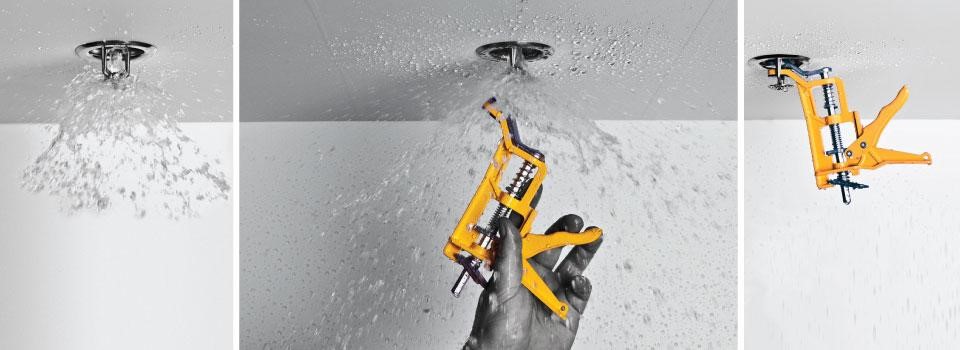No matter what type of business you run, installing a fire sprinkler system is one of the most effective ways to protect your property inventory, equipment, and personnel.
These sophisticated systems are designed to rapidly detect and suppress fires before they can spread, and both threaten lives and cause significant damage.
While you may assume that all fire sprinkler systems have the same basic design and components, several types of fire sprinkler heads are out there. Each fire sprinkler head has its own unique characteristics, and they are designed to handle different situations.
We are breaking down the most common types to help you better understand how fire sprinkler systems work and to help you choose the correct option for your home or business.
If you’re ready to learn, it’s time to get started!
The Most Common Types of Fire Sprinkler Heads

While there are specialized options out there for specific industries, the following are the most common types of fire sprinkler heads and what they are designed for:
1. Sidewall Fire Sprinkler Heads
As their name suggests, sidewall sprinkler heads are installed so that they protrude horizontally from a wall. This unique design makes directing water flow in a specific pattern that can suppress fires in tight spaces easier.
Depending on the type of business, some will feature a combination of sidewall fire sprinkler heads and overhead sprinkler heads, as this ensures more coverage and greater fire suppression capabilities.
What Are Sidewall Fire Sprinkler Heads Designed For?
The primary purpose of sidewall fire sprinkler heads is to cover areas with obstructions and limited ceiling space. They can also be used for facilities that have incredibly high ceilings, like airplane hangars and certain manufacturing facilities.
Narrow walkways and high ceilings, like you would find in a large warehouse, often rely on sidewall sprinkler heads to provide coverage to all pathways and storage areas. In these facilities, it would be difficult to properly cover each laneway with overhead water flow in the event of a fire.
2. Pendant Fire Sprinkler Heads

The pendant fire sprinkler head is the most common type, so it is probably what you have in mind when you try to picture a fire sprinkler system.
These downward-facing sprinkler heads have a circular deflector piece, which ensures that water sprays in all directions when the sprinkler head is activated.
What Are Pendant Fire Sprinkler Heads Designed For?
They are so common because they were designed for general-purpose applications. Thanks to its design, a pendant head provides excellent water coverage, so it works well in just about any type of commercial or retail space, office building, or shared residential space, like an apartment or condominium hallway.
3. Concealed Fire Sprinkler Heads
As you may have guessed, concealed fire sprinkler heads have a discreet design. The sprinkler head sits in a recessed hole in the ceiling, which is then covered with a detachable cover plate.
When the fire sprinkler is activated by temperatures that indicate a fire, the cover plate springs free of the fire sprinkler so that water can be released downwards in a circular pattern.
What Are Concealed Fire Sprinkler Heads Designed For?
Although they function much like pendant fire sprinklers, these concealed sprinkler heads are designed to be a more aesthetically pleasing alternative.
They are commonly seen in upscale indoor spaces that prioritize their appearance but still need an effective fire suppression system. These can include expensive hotels, high-end restaurants, and high-cost shared living spaces, like condominium buildings.
4. Upright Fire Sprinkler Heads
As the name implies, upright sprinkler heads face upwards. When they are activated, the water supply sprays upwards and then cascades downwards in all directions. This can allow for wider water coverage than you would get with a basic pendant fire sprinkler.
What Are Upright Fire Sprinkler Heads Designed For?
Typically, upright sprinklers are used in crowded spaces, like industrial warehouses and factories with assembly lines. They are also a good option for buildings that have partially open ceilings.
Some lofts and trendy restaurants that feature an industrial aesthetic will use them because they are more visually appealing than downward-facing sprinkler heads, but they still offer the same level of fire suppression capabilities.
What Should You Do if a Fire Sprinkler Head Misfires?
No matter which fire sprinkler heads your system uses, they can activate at inappropriate times due to misfires, leaks, and other malfunctions. Unfortunately, this can cause significant water damage, as a typical fire sprinkler head will release approximately 60 gallons of water per minute!
Automatic sprinkler heads can misfire, and they will continue running even after completely suppressing a fire. Again, this can cause serious water damage, especially in a building with sensitive equipment.
Introducing the Shutgun

Fortunately, a simple tool can now shut off most fire sprinkler heads in seconds. The Shutgun was developed to allow individuals to shut off an activated fire sprinkler quickly. Thanks to its one-hand design, it can be operated by a single person on a ladder.
Rather than waiting for firefighters and other fire safety personnel to arrive, you can shut off a fire sprinkler head yourself. This could save your business tens of thousands of dollars in water damage.
There are also Shutgun variations designed to work with different types of fire sprinkler heads, such as the Concealed Head Shutgun.
To learn more about the Shutgun and its variations, click the following link: Get My Shutgun.
Final Words
If you are unsure which type of fire sprinkler heads your business or residential space requires, consult a fire protection professional. These trained professionals will be able to assess your needs and make a recommendation based on the unique fire protection needs of your building.
Remember, an automatic sprinkler system is one of the most essential investments your business will ever make. It may even be a legal requirement in many cases according to local fire codes and regulations.
